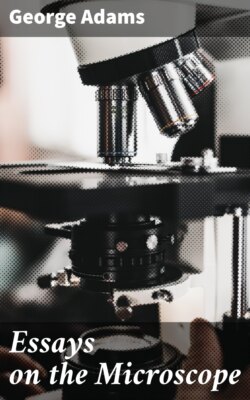Читать книгу Essays on the Microscope - George Comp Adams - Страница 12
На сайте Литреса книга снята с продажи.
OF THE SINGLE MICROSCOPE.
ОглавлениеTable of Contents
The single microscope renders minute objects visible, by means of a small glass globule, or convex lens, of a short focus. Let E Y, Fig. 11. Plate I. represent the eye; and O B a small object, situated very near to it; consequently, the angle of its apparent magnitude very large. Let the convex lens R S be interposed between the eye and the object, so that the distance between it and the object may be equal to the focal length; and the rays which diverge from the object, and pass through the lens, will afterwards proceed, and consequently enter the eye parallel: after which, they will be converged, and form an inverted picture on the retina, and the object will be clearly seen; though, if removed to the distance of six inches, its smallness would render it invisible.
When the lens is not held close to the eye, the object is somewhat more magnified; because the pencils, which pass at a distance from the center of the lens, are refracted inward toward the axis, and consequently seem to come from points more remote from the center of the object, as may be seen in Fig. 12. Plate I. where the pencils which proceed from O and B are refracted inwards, and seem to come from the point i and m.
Fig. 8. Plate I. may, perhaps give the reader a still clearer view, why a convex lens increases the angle of vision. Without a lens, as F G, the eye at A would see the dart B C under the angle b A c; but the rays B F and C G from the extremities of the dart in passing through the lens, are refracted to the eye in the directions f A and g A, which causes the dart to be seen under the much larger angle D A E (the same as the angle f A g.) And therefore the dart B C will appear so much magnified, as to extend in length from D to E.
The object, when thus seen distinctly, by means of a small lens, appears to be magnified nearly in the proportion which the focal distance of the glass bears to the distance of the objects, when viewed by the naked eye.
To explain this further, place the eye close to the glass, that as much of the object may be seen at one view as is possible; then remove the object to and fro, till it appear perfectly distinct, and well defined; now remove the lens, and substitute in its place a thin plate, with a very small hole in it, and the object will appear as distinct, and as much magnified, as with the lens, though not quite so bright; and it appears as much more magnified in this case, than it does when viewed with the naked eye, as the distance of the object from the hole, or lens, is less than the distance at which it may be seen distinctly with the naked eye.
From hence we see, that the whole effect of the lens is to render the object distinct, which it does by assisting the eye to increase the refraction of the rays in each pencil; and that the apparent magnitude is entirely owing to the object being seen so much nearer the eye than it could be viewed without it.
Single microscopes magnify the diameter of the object,[26] as we have already shewn, in the proportion of the focal distance (to the limits of distinct vision with the naked eye) to eight inches. For example, if the semi-diameter of a lens, equally convex on both sides, be half an inch, which is also equal to its focal distance, we shall have as 1⁄2 is to 8, so is 1 to 16; that is, the diameter of the object in the proportion of sixteen to one. 2. As the distance of eight inches is always the same, it follows, that by how much the focal distance is smaller, there will be a greater difference between it and the eight inches; and consequently, the diameter of the object will be so much the more magnified, in proportion as the lenses are segments of smaller spheres. 3. If the object be placed in the focus of a glass globule or sphere, and the eye be behind it in the focus, the object will be seen distinct in an erect situation, and magnified as to its diameter, in the proportion of 3⁄4 of the diameter of the globule to eight inches; thus suppose the diameter of the sphere to be 1⁄10 of an inch, then 3⁄4 of this will be equal to 3⁄40; consequently, the real diameter of the object to the apparent one, as 3⁄40 to 8, or as 3 to 320, or as 1 to 106 nearly.
[26] Cyclopedia, Article Microscope.
